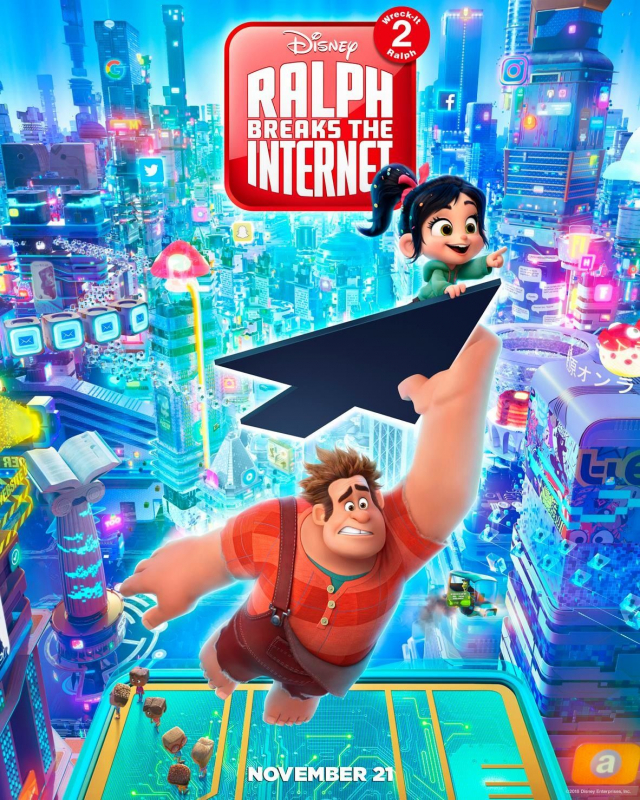
In “Ralph Breaks the Internet,” the friendly arcade game villain-turned-hero Ralph and his friend Vanellope discover the internet, sending them on a new adventure. Image: Disney
Disney’s highly-anticipated animated feature “Ralph Breaks the Internet” is living up to its name ahead of its November release — but for all the wrong reasons.
The studio was hit with a torrent of protest over the depiction of its only black princess in the film, a sequel to the successful “Wreck-It Ralph.”
Princess Tiana — who first appeared in Disney’s 2009 feature “The Princess and the Frog” — only has a small role in the new film, but previews appeared to show her with lighter skin and different facial features than she originally had.
Under intense pressure on social media, the animation giant has apparently redrawn the character — a rare decision just two months ahead of its November 21 release in the United States for the Thanksgiving holiday weekend.
Disney has not formally commented, but Brandi Collins-Dexter, a senior campaign director at advocacy group Color Of Change, which works on ensuring accurate representations of black characters in Hollywood, confirmed the move.
“Disney’s decision to restore Princess Tiana’s image to that of an unapologetically black princess with full lips, dark skin and dark hair in ‘Ralph Breaks the Internet: Wreck-It Ralph 2’ is a victory,” said Collins-Dexter, who reviewed the changes.
“Disney has shown its commitment to addressing the concerns of Color Of Change members and the black community,” she told AFP.
Bringing back what ‘got lost’
In “Ralph Breaks the Internet,” the friendly arcade game villain-turned-hero Ralph and his friend Vanellope discover the internet, sending them on a new adventure.
An early trailer reveals an instantly iconic scene: Vanellope meets all of Disney’s princesses from Snow White to Cinderella, Ariel to Jasmine, and Moana to Tiana, who at first appears in a ball gown with dark skin.
But in another preview scene, a pajama party, her skin is notably lighter, her nose is more narrow and her hair is in loose curls.
So, um…is this supposed to be Princess Tiana in Wreck it Ralph 2? pic.twitter.com/LxBkKjK6zw
— A real-life hoedown. (@HunseckerProxy) August 9, 2018
Actress Anika Noni Rose, a Tony winner who voiced Tiana both for the 2009 film and for “Ralph Breaks the Internet,” took to Instagram to express her surprise.
“This summer, new images were released where she looked very different, with lighter skin and much sharper features,” Rose wrote. “I was as surprised as most of her & my fans were.”
“My team and I immediately put in a call to the studio to talk about the visual changes, and three weeks ago I had a meeting in person with the Wreck It Ralph team, my original animator Mark Henn, and others,” she added.
The team explained how “CGI animation did different things to the characters’ color tones in different light compared to hand drawn original characters,” she said, and showed her “the steps they were taking to bring those things back that got lost.”
Long history
The controversy has squelched some of the buzz around “Ralph Breaks the Internet,” which is sure to be a box office winner at the holidays.
But it is hardly the first example of hand-wringing in Tinseltown over the depiction of non-white characters.
Disney also came in for criticism over its big-screen reboot of “The Lone Ranger” (2013) when Johnny Depp was cast as the renegade’s right-hand man Tonto, who is Native American, even though Depp has said he might be part-Cherokee.
In 2015’s “Aloha,” Emma Stone was cast as a character of Chinese and Hawaiian descent.
At the time, Stone said in an interview with Australian media that she had learned “on a macro level about the insane history of whitewashing in Hollywood and how prevalent the problem truly is.” NVG
RELATED STORIES:
No whitewashing in “To All The Boys I’ve Loved Before” movie!
‘Crazy Rich Asians’ almost got whitewashed by Hollywood, reveals author

